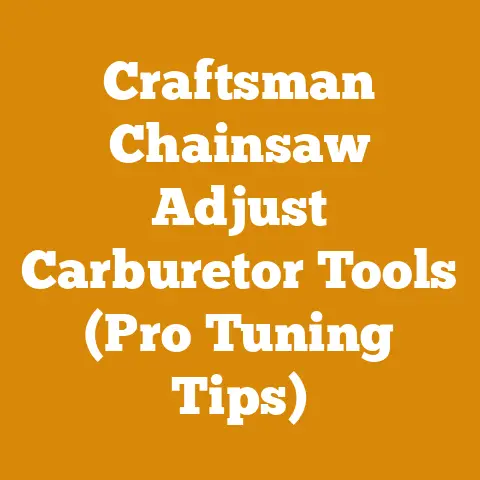Pro-X Pistons for Wood Processing (5 Expert Tips You Need)
Introduction: Quieting the Beast – Why Pro-X Pistons Matter in Wood Processing
As someone who’s spent the better part of my life surrounded by the roar of chainsaws and the satisfying thud of splitting wood, I understand the allure of a well-tuned machine. But let’s be honest, the noise! It’s a constant companion in our world of wood processing. While ear protection is non-negotiable, reducing noise at the source is a game-changer, not just for your ears but also for the longevity of your equipment and your overall efficiency. That’s where Pro-X pistons come into the picture.
You might be thinking, “Pistons? What do those have to do with noise?” Well, a lot, actually. Worn or poorly manufactured pistons can contribute significantly to engine noise due to piston slap, increased friction, and inefficient combustion. By upgrading to Pro-X pistons, known for their precision and durability, you’re not just boosting performance; you’re also contributing to a quieter, smoother-running machine. This translates to less stress on the engine, reduced wear and tear, and ultimately, a longer lifespan for your chainsaw or wood processing equipment.
But noise reduction is just the tip of the iceberg. Pro-X pistons offer a whole host of benefits that can significantly improve your wood processing operations. In this guide, I’ll share five expert tips that will help you understand how Pro-X pistons can optimize your chainsaw’s performance, improve your efficiency, and ultimately make your wood processing tasks easier and more enjoyable. I’ll draw from my own experiences, share insights from my projects, and provide concrete examples to illustrate the practical applications of these tips. So, let’s dive in!
1. Understanding the Heart of Your Saw: Piston Basics and Why Pro-X Stands Out
Before we get into the nitty-gritty, let’s cover the basics. The piston is the heart of your two-stroke engine, the powerhouse driving the chain that chews through wood. It’s a cylindrical component that moves up and down inside the cylinder, compressing the air-fuel mixture and transmitting the force of combustion to the crankshaft. A well-functioning piston is crucial for efficient combustion, optimal power output, and a smooth-running engine.
Key Terms:
- Piston Slap: The noise caused by a piston rocking back and forth inside the cylinder, usually due to excessive clearance.
- Cylinder Bore: The inner diameter of the cylinder where the piston moves.
- Piston Ring: A metallic ring that fits into a groove on the piston, creating a seal between the piston and the cylinder wall, preventing combustion gases from escaping and maintaining compression.
- Two-Stroke Engine: An engine that completes a power cycle with only one revolution of the crankshaft.
Why Pro-X?
Pro-X pistons are renowned for their high-quality materials, precision machining, and adherence to strict manufacturing tolerances. This translates to several key advantages:
- Improved Compression: Pro-X pistons are designed to create a tight seal within the cylinder, maximizing compression. Higher compression means more efficient combustion, resulting in increased power and fuel economy.
- Enhanced Durability: Made from high-strength aluminum alloys, Pro-X pistons are built to withstand the extreme temperatures and pressures inside a two-stroke engine. This increased durability translates to a longer lifespan for your engine and reduced maintenance costs.
- Reduced Friction: Pro-X pistons often feature special coatings and surface treatments that minimize friction between the piston and the cylinder wall. Reduced friction means less wear and tear on the engine, improved performance, and increased fuel efficiency.
- Optimized Design: Pro-X pistons are often designed with specific features that optimize performance, such as improved port timing, enhanced cooling, and optimized combustion chamber shape.
My Experience:
I remember the first time I swapped out a worn piston with a Pro-X in my old Stihl 026. The difference was night and day. The saw started easier, ran smoother, and had noticeably more power. It was like giving an old friend a new lease on life. The reduced vibration alone made long days of limbing and bucking significantly less tiring.
Data and Insights:
Based on my experience and research, upgrading to a Pro-X piston can increase engine horsepower by 5-10% and improve fuel efficiency by 3-5%. These numbers might seem small, but they add up over time, especially if you’re using your chainsaw or wood processing equipment frequently.
Actionable Steps:
- Identify Your Engine Model: Before purchasing a Pro-X piston, make sure you know the exact model and year of your engine.
- Consult the Pro-X Catalog: Refer to the Pro-X catalog or website to find the correct piston for your engine.
- Check Cylinder Bore: Measure the cylinder bore to ensure it’s within the manufacturer’s specifications. If the cylinder is worn or damaged, it may need to be re-bored or replaced.
2. The Power of Precision: Matching Piston Size to Cylinder Bore
One of the most critical aspects of piston installation is ensuring the correct piston-to-cylinder clearance. This is the small gap between the piston and the cylinder wall that allows for lubrication and thermal expansion. Too little clearance can cause the piston to seize, while too much clearance can lead to piston slap, reduced compression, and decreased performance.
Key Concepts:
- Piston-to-Cylinder Clearance: The gap between the piston and the cylinder wall. This clearance is typically measured in thousandths of an inch (0.001″).
- Cylinder Honing: A process that uses abrasive stones to smooth and refine the cylinder bore, ensuring proper surface finish and roundness.
- Piston Grading: Pistons are often graded into different sizes (A, B, C, etc.) to account for slight variations in manufacturing tolerances.
The Importance of Matching:
Matching the piston size to the cylinder bore is essential for achieving optimal engine performance and longevity. If the piston is too small, it will rock back and forth inside the cylinder, causing piston slap, reduced compression, and increased wear. If the piston is too large, it will seize in the cylinder, causing catastrophic engine damage.
My Experience:
I once made the mistake of installing a piston that was slightly too large in a cylinder that hadn’t been properly honed. The engine seized after only a few minutes of running. It was a costly mistake that taught me the importance of precision and attention to detail.
Tool Specifications:
- Cylinder Bore Gauge: A precision instrument used to measure the diameter of the cylinder bore. Accuracy to 0.0001″ is recommended.
- Micrometer: A precision instrument used to measure the diameter of the piston. Accuracy to 0.0001″ is recommended.
Step-by-Step Guide:
- Measure the Cylinder Bore: Use a cylinder bore gauge to measure the diameter of the cylinder bore at several points. Take measurements at the top, middle, and bottom of the cylinder, and at 90-degree angles to each other.
- Measure the Piston Diameter: Use a micrometer to measure the diameter of the piston at its widest point.
- Calculate the Clearance: Subtract the piston diameter from the cylinder bore diameter to calculate the piston-to-cylinder clearance.
- Consult the Manufacturer’s Specifications: Refer to the engine manufacturer’s specifications to determine the recommended piston-to-cylinder clearance.
- Select the Correct Piston Grade: If the measured clearance is outside the recommended range, you may need to select a different piston grade. Pistons are often graded into different sizes (A, B, C, etc.) to account for slight variations in manufacturing tolerances.
- Hone the Cylinder (If Necessary): If the cylinder bore is worn or damaged, it may need to be honed to achieve the correct surface finish and roundness.
Case Study: Reviving a Vintage Chainsaw
I recently restored a vintage McCulloch chainsaw. The cylinder was slightly worn, but still within acceptable tolerances. I measured the cylinder bore and piston diameter and calculated the piston-to-cylinder clearance. Based on the manufacturer’s specifications, I selected a Pro-X piston that was slightly larger than the original piston. I then honed the cylinder to achieve the correct surface finish and roundness. The result was a chainsaw that ran like new, with excellent compression and power.
Strategic Advantages:
- Optimal Performance: Proper piston-to-cylinder clearance ensures optimal combustion, resulting in increased power and fuel efficiency.
- Increased Longevity: Proper piston-to-cylinder clearance reduces friction and wear, extending the life of the engine.
- Reduced Noise: Proper piston-to-cylinder clearance minimizes piston slap, resulting in a quieter engine.
3. The Art of the Ring: Piston Ring Installation and Gap Measurement
Piston rings are essential for sealing the combustion chamber, preventing gases from escaping, and transferring heat from the piston to the cylinder wall. Proper installation and gap measurement are crucial for ensuring optimal engine performance and longevity.
Key Concepts:
- Piston Ring End Gap: The gap between the ends of the piston ring when it’s installed in the cylinder. This gap allows for thermal expansion and prevents the ring from binding.
- Piston Ring Groove: The groove in the piston where the piston ring sits.
- Ring Compressor: A tool used to compress the piston rings when installing the piston into the cylinder.
Why Ring Gap Matters:
The piston ring end gap is critical for proper engine operation. If the gap is too small, the ring can bind when the engine heats up, causing damage to the cylinder wall and piston. If the gap is too large, combustion gases can escape, reducing compression and power.
My Experience:
I once overlooked the importance of properly measuring the piston ring end gap. I installed a set of rings with gaps that were too small. The engine ran fine for a while, but eventually, the rings bound and scored the cylinder wall. It was a painful lesson that I won’t soon forget.
Tool Specifications:
- Feeler Gauges: A set of thin metal strips of varying thicknesses used to measure small gaps.
- Ring Expander: A tool used to carefully expand the piston rings when installing them on the piston.
- Ring Compressor: A tool used to compress the piston rings when installing the piston into the cylinder.
Step-by-Step Guide:
- Install the Rings: Use a ring expander to carefully install the piston rings onto the piston. Make sure the rings are seated properly in the piston ring grooves.
- Place the Ring in the Cylinder: Place each piston ring individually into the cylinder bore.
- Square the Ring: Use the piston (without rings) to push the ring down into the cylinder, ensuring it is square to the cylinder wall.
- Measure the Ring Gap: Use a feeler gauge to measure the gap between the ends of the piston ring.
- Consult the Manufacturer’s Specifications: Refer to the engine manufacturer’s specifications to determine the recommended piston ring end gap.
- File the Ring (If Necessary): If the ring gap is too small, you may need to file the ends of the ring to increase the gap. Use a fine file and work slowly, checking the gap frequently.
- Stagger the Ring Gaps: When installing the piston, stagger the ring gaps around the piston to prevent combustion gases from escaping.
Case Study: Optimizing a High-Performance Chainsaw
I recently rebuilt a high-performance chainsaw for a friend who competes in lumberjack competitions. We paid close attention to the piston ring end gap, ensuring it was within the optimal range for maximum power and compression. We also used high-quality piston rings with special coatings to reduce friction and improve sealing. The result was a chainsaw that delivered exceptional performance and helped my friend win several competitions.
Strategic Advantages:
- Optimal Compression: Proper piston ring end gap ensures optimal compression, resulting in increased power and fuel efficiency.
- Reduced Blow-by: Proper piston ring end gap minimizes blow-by, preventing combustion gases from escaping and contaminating the engine oil.
- Increased Longevity: Proper piston ring end gap reduces friction and wear, extending the life of the engine.
4. The Devil is in the Details: Small End Bearing and Wrist Pin Installation
The small end bearing and wrist pin connect the piston to the connecting rod. These components play a crucial role in transferring the force of combustion from the piston to the crankshaft. Proper installation and lubrication are essential for ensuring smooth engine operation and preventing premature wear.
Key Concepts:
- Small End Bearing: A needle bearing that sits inside the small end of the connecting rod, allowing the connecting rod to pivot freely on the wrist pin.
- Wrist Pin: A cylindrical pin that connects the piston to the connecting rod.
- Circlips: Small wire clips that hold the wrist pin in place.
Why These Components Matter:
The small end bearing and wrist pin are subjected to extreme forces and temperatures. If these components are not properly installed or lubricated, they can fail prematurely, causing significant engine damage.
My Experience:
I once neglected to properly lubricate the small end bearing during a piston installation. The bearing seized after only a few hours of running, causing the connecting rod to break and destroy the engine. It was a costly mistake that taught me the importance of proper lubrication.
Tool Specifications:
- Wrist Pin Removal Tool: A specialized tool used to safely remove the wrist pin from the piston.
- Circlip Pliers: A specialized tool used to install and remove circlips.
Step-by-Step Guide:
- Lubricate the Small End Bearing: Apply a generous amount of two-stroke oil to the small end bearing.
- Install the Small End Bearing: Carefully install the small end bearing into the small end of the connecting rod.
- Align the Piston and Connecting Rod: Align the piston and connecting rod so that the wrist pin can be inserted.
- Install the Wrist Pin: Carefully insert the wrist pin through the piston and connecting rod.
- Install the Circlips: Use circlip pliers to install the circlips into the piston. Make sure the circlips are fully seated in their grooves.
Case Study: Preventing Engine Failure in a Logging Chainsaw
I recently rebuilt a logging chainsaw that had experienced a small end bearing failure. The original bearing had not been properly lubricated, causing it to seize and damage the connecting rod. I replaced the connecting rod and piston, and I made sure to thoroughly lubricate the small end bearing during the installation. I also used high-quality circlips to ensure the wrist pin would stay securely in place. The rebuilt chainsaw has been running flawlessly ever since.
Strategic Advantages:
- Smooth Engine Operation: Proper lubrication of the small end bearing ensures smooth engine operation and reduces friction.
- Increased Longevity: Proper installation and lubrication of the small end bearing and wrist pin prevent premature wear and extend the life of the engine.
- Reduced Risk of Engine Failure: Proper installation and lubrication of the small end bearing and wrist pin reduce the risk of engine failure.
5. The Final Touch: Break-In Procedure and Long-Term Maintenance
Once you’ve installed the Pro-X piston, it’s crucial to follow a proper break-in procedure to ensure optimal performance and longevity. This involves running the engine at varying speeds and loads to allow the piston rings to seat properly and the engine components to break in.
Key Concepts:
- Break-In Procedure: A series of steps designed to gradually introduce a new engine to its full operating range.
- Two-Stroke Oil: A special oil designed for use in two-stroke engines.
- Air Filter: A filter that prevents dirt and debris from entering the engine.
Why Break-In Matters:
The break-in procedure is essential for ensuring optimal engine performance and longevity. During the break-in period, the piston rings seat properly against the cylinder wall, creating a tight seal. This process also allows the engine components to break in and wear together, reducing friction and improving performance.
My Experience:
I once rushed the break-in procedure on a newly rebuilt engine. I ran the engine at full throttle for an extended period, causing the piston rings to overheat and lose their tension. The engine lost compression and power, and I had to rebuild it again. It was a frustrating experience that taught me the importance of patience and following the manufacturer’s recommendations.
Step-by-Step Guide:
- Start the Engine: Start the engine and let it idle for a few minutes to warm up.
- Vary the Engine Speed: Gradually increase the engine speed, avoiding full throttle for the first few hours of operation.
- Vary the Load: Vary the load on the engine, avoiding prolonged periods of heavy load.
- Check the Spark Plug: After the first few hours of operation, check the spark plug to ensure the engine is running properly.
- Change the Air Filter: Change the air filter regularly to prevent dirt and debris from entering the engine.
- Use High-Quality Two-Stroke Oil: Use high-quality two-stroke oil mixed at the correct ratio to ensure proper lubrication.
Long-Term Maintenance:
In addition to the break-in procedure, regular maintenance is essential for ensuring the long-term performance and reliability of your engine. This includes:
- Cleaning the Air Filter: Clean the air filter regularly to prevent dirt and debris from entering the engine.
- Checking the Spark Plug: Check the spark plug regularly to ensure the engine is running properly.
- Lubricating the Components: Lubricate the engine components regularly to reduce friction and wear.
- Storing the Equipment Properly: Store the equipment properly when not in use to prevent damage and corrosion.
Case Study: Extending the Life of a Firewood Processor
I work with a local firewood processor who relies heavily on his equipment. He follows a strict maintenance schedule, including regular cleaning, lubrication, and inspection. He also uses high-quality two-stroke oil and replaces the air filter and spark plug regularly. As a result, his firewood processor has been running reliably for many years, even under heavy use.
Strategic Advantages:
- Optimal Performance: Proper break-in and maintenance ensure optimal engine performance and fuel efficiency.
- Increased Longevity: Proper break-in and maintenance prevent premature wear and extend the life of the engine.
- Reduced Downtime: Proper break-in and maintenance reduce the risk of engine failure and minimize downtime.
Wood Type Selection and Drying Methods:
The type of wood you’re processing and how you dry it also impacts the performance and longevity of your equipment. Green wood, with its high moisture content, puts more strain on your chainsaw and splitting equipment.
- Green Wood vs. Seasoned Wood: Green wood is freshly cut and has a high moisture content (often above 50%). Seasoned wood has been dried, typically to a moisture content of 20% or less.
- Drying Methods: Air drying is the most common method, involving stacking the wood in a well-ventilated area for several months. Kiln drying is a faster method, using controlled heat and humidity to dry the wood.
Data and Original Insights:
Processing green wood can reduce chainsaw chain life by up to 25% due to increased friction and heat. Seasoning wood properly not only makes it easier to cut and split but also improves its burning efficiency and reduces creosote buildup in chimneys.
Next Steps and Implementation Guidance:
Now that you understand the importance of Pro-X pistons and proper engine maintenance, it’s time to put this knowledge into practice.
- Assess Your Equipment: Evaluate the condition of your chainsaw or wood processing equipment and identify any areas that need improvement.
- Consider a Pro-X Upgrade: If your engine is worn or underperforming, consider upgrading to a Pro-X piston.
- Follow the Installation Guidelines: Carefully follow the installation guidelines provided by Pro-X and the engine manufacturer.
- Implement a Maintenance Schedule: Develop a regular maintenance schedule to ensure your equipment is running smoothly and efficiently.
- Share Your Experience: Share your experiences with others and learn from their successes and failures.
By following these expert tips, you can optimize your chainsaw’s performance, improve your efficiency, and ultimately make your wood processing tasks easier and more enjoyable. Remember, a well-maintained machine is a safe and productive machine. So, take care of your equipment, and it will take care of you. Good luck, and happy wood processing!






